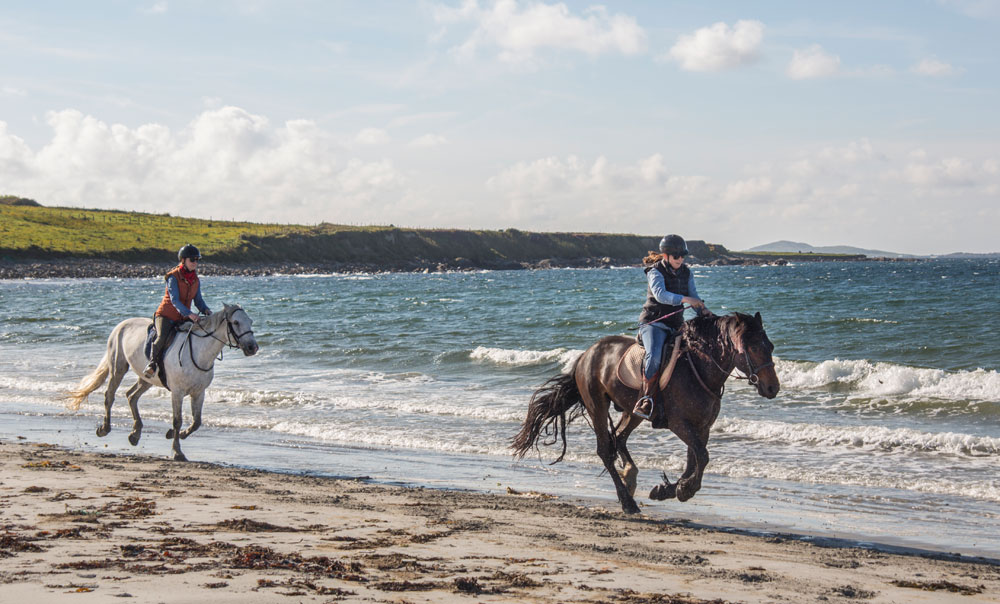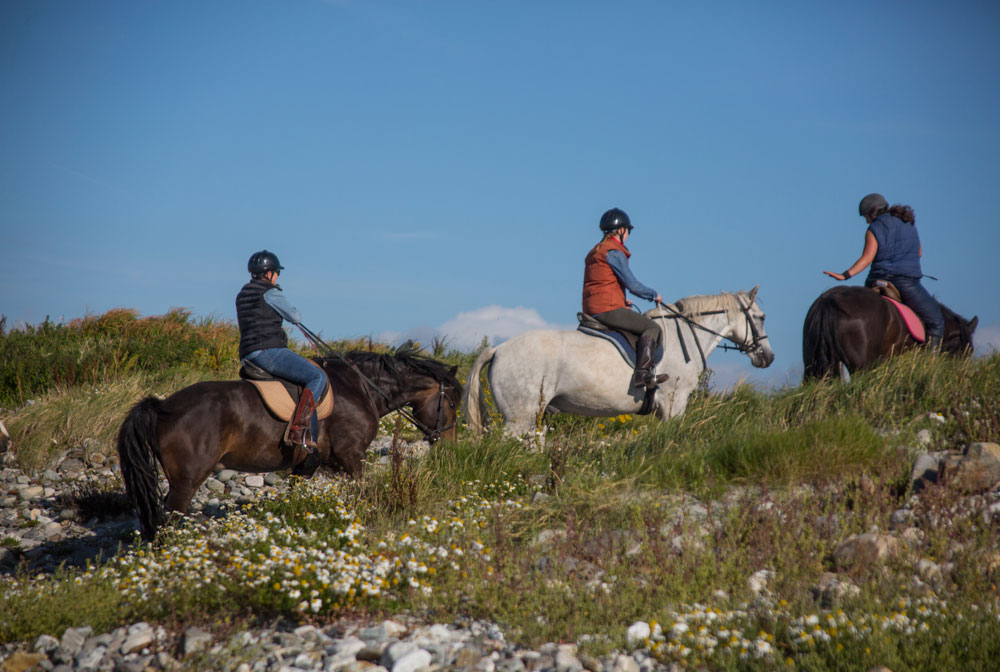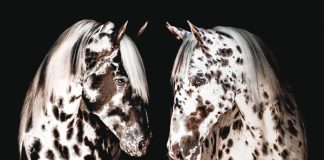
The crisp clip-clop of steel horseshoes striking stone roads competed with the sound of surf crashing to shore as our group of riders trotted toward Cleggan Beach in Ireland. The Connemara/Irish Cob under me perked up at the smell of the salty air and the sound of the waves. A thrilling beach gallop on my trusty horse in the Emerald Isle was mere moments away.
Ireland is a horse lover’s paradise, whether you’re an expert in an English saddle or a novice with little riding know-how. With a little research, a reputable stable to book with and a sense of adventure, you can experience the magical ride of your dreams.
A Perfect Plan for an Emerald Isle Horse Vacation
Tourism is a thriving industry in Ireland, and many cities offer a tourism agency that can assist in booking adventures like horseback riding. The horse trekking companies that work with official Irish tourism offices are often accredited through the Association of Irish Riding Establishments (AIRE), and insured, making them a good choice for an adventure.
Though my Irish adventure began in Dublin, I was positive that I wanted to ride on the beach aboard an Irish horse. Over my 20-plus years of horseback experience, which includes jumping, youth rodeo events, western pleasure and working cow horse, I had not had many opportunities for the quintessential beach ride. Sand in your face, thundering hooves and surf pounding as you gallop on beach.
With this vision in mind, my friend Anna Morrison and I waited to book a horse vacation in Ireland until we reached the western edge of our travels.
The second-to-last morning of the trip, we walked into the Tourism Ireland office in Clifden. There were several stables that offered rides: rides near old castles, rides in the country and rides along the coast. However, for us the choice was easy. The Cleggan Beach Riding Centre offered a beautiful beach gallop.
After a quick call to schedule our ride, we were set. It was an afternoon riding appointment. All day I couldn’t wait to get to the stables, and finally the time arrived.
Well-Matched Mounts
I felt like a kid again, trying to listen to the pre-ride instructions, but all the while straining to catch a glimpse of the horses. I hoped to meet the horse of my Irish dreams—something adorable, with feathered feet and a flowing mane.
First, though, the Cleggan instructors fit each rider in our group with a helmet and ensured that our boots safely fit into and would release from a stirrup. Anna and I both had extensive experience riding stock horses in Texas, and our western-style cowboy boots made for good-natured comments about our “cowboy style.”
Up until this point, it never crossed my mind that we would be sitting in English saddles.
“How long has it been since you rode English? It’s been at least a decade for me,” Anna said. “Let’s hope that muscle memory kicks in!”
One by one, the horses were led out and paired with riders based on ability. A father that had never ridden was paired with a large black-and-white piebald that looked like he was asleep on his feet—a nice match. A small roan pony was introduced to a little girl; the child was instantly smitten. As each rider mounted and was settled safely in the saddle with stirrups adjusted, my anxiety grew.
“What if I don’t find my balance in the English saddle? What if they give me a troublesome mount because I said I was experienced?” The worries began to pile up in my head. Soon Oscar was led toward me.
A stout, brown gelding with an unruly mane, thick body, soft brown eyes and feathery feet stood in front of me, and he was most definitely assessing me as I gave him the once-over. Oscar was precious!
Solidly mounted on my 8-year-old Connemara-Cob cross, I looked over to find Anna beaming at me from her seat on Chip, a 12-year-old gray Connemara. We were ready.
Before embarking on our beach trek, the instructors had each rider take a practice lap at the trot. Those tackling a beach canter—just me and Anna—were required to take one practice lap to be sure we could handle our horses. At last we set out, riding along the main road in to Cleggan before turning south of town onto a single-lane road.
My smile beamed with my delight as we walked past stones piled in what was once a house, trotted down lanes bordered by vividly red-flowered plants, and greeted the cattle and horses that were attracted to the fences by our presence. Yet nothing prepared me for seeing the beach.

Making Magic
The blacktop road gave way to white as the horses crested the hill, their hooves sinking in the sand. For some reason, I did not imagine Irish beaches to have sand to rival that of the Caribbean. But here we were, near the North Atlantic Ocean, facing a sea of blue-green water, with emerald-green hills to our left and right, and a quaint Irish fishing village behind us. It was picture perfect.
The Cleggan Beach Riding Centre instructors paused for us to take in the view, take some photographs, and took time to point out the historic features of the area, including an ancient Celtic monument that overlooked the beach. Our riding group was then split into trotters and gallopers.
There would be several trips up and down the beach. Before setting the riders on their path, the instructors gave the less-experienced riders key instruction on steering and stopping.
With giddy smiles, Anna and I awaited our turn to traverse the beach. She situated her horse in front of mine, with the ocean to her left and the dunes to the right.
“Can you believe we are about to gallop our horses on an Irish beach? Look at this—it’s beautiful!” said Anna.
And then the only sound was the wind rushing past my ears as I leaned forward, urging Oscar into a canter, then letting him eat up the ground as he splashed down the beach. It was wet, it was sandy, it was salty. It was a perfect ride.
I heard the rhythm of Oscar’s hooves pounding the edge of the surf, and with each stride I was soaring. With my heels down and weight centered, I forgot to be concerned about the English saddle and instead just enjoyed the ride.
Laughter carried from the novice group to our ears, as each trip they made the children and adults alike grew bolder in their speed. The excitement in the air was palpable.
All too soon, I guided Oscar from sand to blacktop. There was sand on my face, sand covering my Western boots, and I noticed Oscar’s coat was shining with droplets of sea water. Yet both he and I were relaxed.
The walk back to the Centre was quiet, with riders all smiling at the beach adventure. A young family would take home memories of their ride, and perhaps inspire one of the children for riding lessons. No matter the saddle experience before we set out on our trek, each one of us was returning to the barn with a better understanding of riding.
Anna and I were the last to leave the arena. We lingered over saying goodbye to our respective mounts. In the car headed back to Clifden, with the windows down and the smell of sea in the air, I was all smiles. Ireland offered this Texas stock-horse rider hope to fulfill a dream, and the reality was so much more than I could have hoped.
Horses of Ireland
The horse holds a special place in the culture and heritage of Ireland. According to Irish Horse Gateway, a website connecting buyers and sellers of Irish horses, the country is home to three native breeds: the Connemara pony, the Irish Cob and the Kerry Bog pony.
In addition, horse owners in Ireland created three more breeds through careful selection: the Irish Draught, a sturdy horse that could handle both riding and farm work; the Irish Sport Horse, a cross of Thoroughbred and Irish Draught; and the newest, the Irish Warmblood, a stud book officially recognized in 2009.
The Irish Cob and Connemara pony are advertised in most riding adventures, and it’s no secret why they’re popular. Irish Cobs in particular are noted for their excellent temperament and flowing hair. Their short, wide backs make them very comfortable under saddle. The Connemara is beloved for its versatility, athleticism and cheerful character.
Thoroughbreds also are a point of pride for the Irish. The Irish National Stud, a Thoroughbred breeding facility established in 1900, is located in County Kildare and manages the official stud book. The Irish National Stud is home to stallions renowned for steeplechase and racing. As a national organization, the Irish National Stud truly belongs to the people of Ireland. Visitors can view the stallions and living legends that are retired to the farm, as well as visit the historic horse museum.
From the carriage horses in Dublin and the horses still used to work farms to the ponies that carry tourists on hacks, horses thrive in Ireland.
For more information on Irish horse history, start by visiting irishnationalstud.ie or theconnemarapony.ie.
This article about exploring the Emerald Isle by horseback originally appeared in the January 2018 issue of Horse Illustrated magazine. Click here to subscribe!





